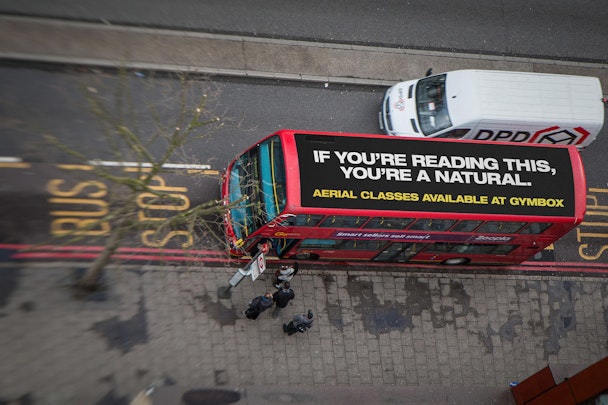The luddites attacked the looms, will creatives attack the AI fakes?
A fake Gymbox campaign sparked yet another debate on the importance of ads being real or not.

Gymbox's fake ad / Gymbox
The ad, which was simply a mock-up of an existing stock image with a headline on the top of the bus, generated some significant heat and criticism. It was a simple creative idea and arguably a win for the brand. But it’s sparked lively debate across the industry; does it matter that it was real or not? Whether it has actually physically happened or not is irrelevant in my mind. The only losers are the media owners.
For the brand and the creatives, the idea has been realized and communicated, and that’s a win. Remember Paddy Power’s rainforest campaign that stood in support of the England Football Team during the Rio World Cup? That whipped up an immense amount of conversation for 48 hours before they revealed it wasn’t real and the result of 3D animation. Then came the genius of revealing the true impact of deforestation on the Amazon.
Advertisement
Consumers see these types of executions on social rather than the physical installation on the bus or in the rainforest anyway. As creatives, we’re always looking to create images that engage consumers, get shared and generate conversation - as both Paddy Power and Gymbox did so well. So why does the physical creation of the ad matter?
All this got me thinking about how this applies to fears of AI taking jobs. If Gymbox can make a fake campaign that can take a stock image and two seconds of Photoshop and become the most talked about campaign of the moment, then what’s to say AI won’t do that too and eradicate the creatives? Cut out the middleman and reduce the cost of a campaign?
The Gymbox ad could have been created with Midjourney, an image-based generative AI tool for creatives, but perhaps then it would risk coming under fire for being ‘too fake’. The reality of fake imagery raises serious issues around truth v mistruths and how we can trust our own eyes. And for the industry, we have to ask ourselves, what does it really mean to be creative anymore?
Advertisement
What it takes to be ‘creative’
Creativity is an all-encompassing statement but in simplistic terms, it can be broken down into two distinct attributes. There’s the ability to vision and conceive the idea; then there’s the craft needed to realize that vision. Those skills are hard-earned through dedication and perseverance. It’s the creative journey we embark on, the challenge of learning new skills, the failures, the happy mistakes, and the satisfaction of mastery.
This holistic state of being was once irreplicable. But with tech evolution reaching its most recent peak, the skills we once cherished, admired and spent our lives mastering can be achieved with the click of a button. So, there’s no wonder that there’s mass anxiety about tech making creatives redundant. Zoom’s own chief recently berated the platform, controversially stating that “video calls harm creativity because they remove the nuances of IRL human interaction.” His point is that Zoom needs face to-face contact to truly collaborate and create.
Collaborating to make the vision better is the very reason we bring different skills and perspectives to the work. Now don’t get me wrong, I continue to disappear down wormholes with Midjourney, fine-tuning prompts, revisioning, upscaling, and iterating on the previous output, but it’s just another form of creative direction.
Suggested newsletters for you
Human vs Machine
Ultimately, as humans, we will always attach more value to things that are authentic, original, one-of-a-kind, ideas that resonate with us, connect with us and make us feel something or see things from someone else’s perspective. I don’t believe a machine can do that yet. As it stands, AI is another tool in our creative arsenal. It’s the paintbrush to the painter, and for that reason, the responsibility to be transparent still strongly lies with the creatives, the brand and the media agency.
As with every trend, there will be a full circle and we will see a resurgence in the appreciation of older tech and craft skills because of its growing scarcity.
Spot the difference
Upon investigation, there was no malice in the Gymbox activation; it was not fakery of the obvious kind. There was no huge 3D mascara wand or giant sky-scraper-sized Barbie. It was not done to deceive or trick the intended audience for one party’s gain. Instead, it subtly was its own worst enemy in the eyes of creatives and the media.
If it were a deepfake AI-generated video of a public figure distorting their point of view, then it would be a whole different story.
Grant Hunter is global executive creative director at Iris Worldwide.
